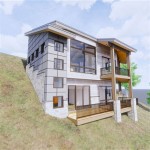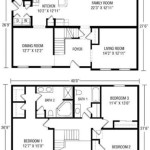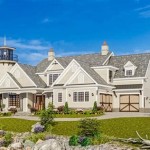House floor plan ideas encompass the arrangement and organization of various spaces within a home, including rooms, hallways, and circulation patterns. They provide a blueprint for the overall layout and functionality of a dwelling. For instance, a well-designed floor plan can optimize space utilization, enhance natural light flow, and facilitate smooth movement throughout the residence.
The development of house floor plan ideas involves careful consideration of factors such as the number of bedrooms and bathrooms, the desired level of privacy, and the integration of indoor and outdoor living areas. Each room’s purpose, size, and relationship to other spaces are thoughtfully planned to create a cohesive and efficient living environment.
As we delve deeper into the topic, we will explore different types of house floor plan ideas, their advantages and disadvantages, and how to choose the most suitable one for your specific needs. We will also provide practical tips and inspiration to help you design a floor plan that meets your lifestyle and preferences.
When considering house floor plan ideas, it is important to keep in mind the following key points:
- Functionality and flow
- Natural light and ventilation
- Privacy and separation
- Space utilization and storage
- Indoor-outdoor connection
- Accessibility and adaptability
- Style and aesthetics
- Cost and budget
- Future needs and flexibility
- Personal preferences and lifestyle
By carefully considering these factors, you can create a house floor plan that meets your specific requirements and provides a comfortable and enjoyable living environment.
Functionality and flow
Functionality and flow are essential considerations in house floor plan ideas. A well-designed floor plan should allow for smooth and efficient movement throughout the home, while also providing dedicated spaces for different activities and functions. Here are some key aspects to consider:
1. Circulation patterns: The floor plan should facilitate easy movement between different areas of the home, including the kitchen, living room, bedrooms, and bathrooms. Avoid creating bottlenecks or dead-end spaces that hinder circulation. Consider the frequency of use for each space and plan accordingly.
2. Room adjacencies: The placement of rooms in relation to each other should be carefully considered. For example, the kitchen should be conveniently located near the dining room and family room, while bedrooms should be separated from high-traffic areas for privacy.
3. Space utilization: Make efficient use of available space by designing rooms that are appropriately sized and shaped. Avoid creating wasted spaces or underutilized areas. Consider multi-purpose spaces that can serve multiple functions, such as a guest room that doubles as a home office.
4. Storage solutions: Adequate storage space is essential for keeping the home organized and clutter-free. Incorporate built-in storage solutions, such as closets, cabinets, and shelves, throughout the house. Consider the specific storage needs of each room and provide customized solutions accordingly.
By carefully planning for functionality and flow, you can create a house floor plan that meets your lifestyle needs and provides a comfortable and enjoyable living environment.
Natural light and ventilation
Natural light and ventilation are crucial aspects to consider in house floor plan ideas. A well-designed floor plan should maximize the use of natural light to create a bright and inviting living environment. It should also incorporate strategies to promote proper ventilation and air circulation throughout the home.
1. Window placement and orientation: The placement and orientation of windows can significantly impact the amount of natural light entering a space. South-facing windows allow for maximum sunlight exposure, while north-facing windows provide more diffused light. Consider the specific needs of each room when positioning windows and choose the appropriate size and type of windows to optimize natural light.
2. Skylights and clerestory windows: Skylights and clerestory windows are excellent options for bringing natural light into interior spaces that may not have access to direct sunlight. Skylights are installed on the roof, while clerestory windows are placed high on the wall, near the ceiling. These openings allow for natural light to penetrate deep into the home, even in areas with limited window space.
3. Ventilation strategies: Proper ventilation is essential for maintaining a healthy and comfortable indoor environment. Cross-ventilation, which involves creating openings on opposite sides of a space, is an effective way to promote air flow and remove stale air. Consider the placement of windows, doors, and vents to facilitate cross-ventilation in all rooms.
4. Mechanical ventilation: In some cases, mechanical ventilation may be necessary to supplement natural ventilation. This can include the use of fans, exhaust systems, and air conditioning units. Mechanical ventilation can help to improve air quality, remove excess moisture, and regulate temperature.
By carefully considering natural light and ventilation in your house floor plan, you can create a home that is both bright and inviting, while also promoting good indoor air quality and a comfortable living environment.
Privacy and separation
Privacy and separation are important considerations in house floor plan ideas, especially in homes with multiple occupants or those who value their own space. A well-designed floor plan should provide private spaces for individuals to retreat to, as well as separate public areas for shared activities and entertaining.
1. Bedroom placement: The placement of bedrooms in a house floor plan should prioritize privacy. Master bedrooms should be located in a secluded area of the home, away from high-traffic areas and shared spaces. Secondary bedrooms should also be positioned to minimize noise and disturbance from other rooms.
2. Bathroom privacy: Bathrooms should be designed to provide privacy for users. This can be achieved by using frosted glass doors, installing separate vanities and toilets, and incorporating soundproofing measures. Consider the location of bathrooms in relation to bedrooms and public areas to ensure that they are easily accessible yet private.
3. Separate living spaces: For homes with multiple occupants, it is important to create separate living spaces where individuals can retreat to for privacy. This can include a dedicated study or home office, a cozy reading nook, or a quiet sitting area. These spaces should be located away from high-traffic areas and provide a sense of seclusion.
4. Multi-generational living: In multi-generational homes, privacy and separation are particularly important. Consider creating separate living quarters for elderly parents or adult children, with their own bedrooms, bathrooms, and living spaces. This allows for greater independence and privacy while still maintaining a sense of connection within the family.
By carefully considering privacy and separation in your house floor plan, you can create a home that meets the needs of all occupants and provides a comfortable and enjoyable living environment for everyone.
Space utilization and storage
Space utilization and storage are crucial considerations in house floor plan ideas, especially for maximizing available space and maintaining a clutter-free living environment. A well-designed floor plan should incorporate strategies to optimize space utilization and provide ample storage solutions throughout the home.
- Multi-purpose spaces: Multi-purpose spaces are a great way to maximize space utilization in a house floor plan. These spaces can serve multiple functions, such as a guest room that doubles as a home office or a living room that can be converted into a dining area for special occasions. By incorporating multi-purpose spaces, you can reduce the need for additional rooms and make more efficient use of available space.
- Built-in storage: Built-in storage solutions are a great way to maximize space utilization and keep the home organized. Consider incorporating built-in cabinets, shelves, and drawers into the design of your house floor plan. These built-in storage solutions can be customized to fit specific spaces and can provide ample storage for items such as clothing, linens, books, and household supplies.
- Vertical storage: Vertical storage solutions are a great way to maximize space utilization in smaller homes or rooms with limited floor space. Consider using tall shelves, stackable bins, and hanging organizers to store items vertically. This can help to free up floor space and create a more spacious and organized living environment.
- Hidden storage: Hidden storage solutions can be a great way to keep the home organized and clutter-free. Consider incorporating hidden storage spaces into the design of your house floor plan, such as under-bed storage, pull-out drawers, and secret compartments. These hidden storage spaces can be used to store items that are not frequently used or that you want to keep out of sight.
By carefully considering space utilization and storage in your house floor plan, you can create a home that is both spacious and organized, providing a comfortable and enjoyable living environment for everyone.
Indoor-outdoor connection
An indoor-outdoor connection is an important aspect to consider in house floor plan ideas, as it can enhance the overall livability and enjoyment of the home. By seamlessly integrating indoor and outdoor spaces, you can create a more spacious and inviting living environment that promotes a connection with nature.
- Patios and decks: Patios and decks are excellent ways to extend the living space outdoors. They provide a dedicated area for outdoor dining, entertaining, and relaxation. When designing a patio or deck, consider its size, shape, and orientation to maximize sunlight exposure and views of the surrounding landscape.
- Sliding glass doors and large windows: Sliding glass doors and large windows can help to blur the boundaries between indoor and outdoor spaces. They allow for natural light to penetrate deep into the home and provide easy access to the outdoors. Consider using floor-to-ceiling windows or sliding glass doors to create a more open and inviting living environment.
- Indoor-outdoor rooms: Indoor-outdoor rooms are a great way to create a seamless transition between indoor and outdoor spaces. These rooms are typically located on the ground floor and feature large windows or doors that open up to the outdoors. Indoor-outdoor rooms can be used for a variety of purposes, such as dining, entertaining, or simply relaxing and enjoying the views.
- Courtyards and atriums: Courtyards and atriums are enclosed outdoor spaces that can be incorporated into the design of a house floor plan. They provide a private and sheltered outdoor area that can be used for relaxation, gardening, or entertaining. Courtyards and atriums can also help to bring natural light and ventilation into the home.
By carefully considering the indoor-outdoor connection in your house floor plan, you can create a home that is both spacious and inviting, while also providing a strong connection with the outdoors.
Accessibility and adaptability
Accessibility and adaptability are important considerations in house floor plan ideas, especially for those who have mobility impairments or who may need to adapt their home in the future.
- Universal design: Universal design principles aim to create spaces that are accessible and usable by people of all abilities. Consider incorporating features such as wide doorways, ramps instead of stairs, and accessible bathrooms with roll-in showers and grab bars.
- Future-proofing: Future-proofing your home involves making design choices that will allow for easy adaptation as your needs change. Consider using modular furniture that can be easily reconfigured, and incorporate features such as adjustable countertops and sinks that can be raised or lowered.
- Multi-generational living: If you plan to have multi-generational living situations, it is important to consider the needs of all occupants. This may involve creating separate living quarters with their own bedrooms, bathrooms, and living spaces, as well as ensuring that common areas are accessible to all.
- Assistive technology: Assistive technology can play a significant role in making a home more accessible. Consider incorporating features such as smart home systems that can be controlled by voice or smartphone, and installing assistive devices such as stairlifts or wheelchair ramps.
By carefully considering accessibility and adaptability in your house floor plan, you can create a home that is comfortable, safe, and enjoyable for everyone, regardless of their abilities or future needs.
Style and aesthetics
Style and aesthetics play a significant role in house floor plan ideas, as they determine the overall look and feel of the home. The style of a house floor plan can range from traditional to modern, and the aesthetic choices can influence everything from the layout of the rooms to the selection of finishes and materials.
When considering the style of a house floor plan, it is important to think about the desired ambiance and atmosphere of the home. Traditional floor plans often feature symmetrical layouts, formal living and dining rooms, and intricate architectural details. Modern floor plans, on the other hand, tend to be more open and flowing, with an emphasis on natural light and clean lines.
The aesthetic choices made in a house floor plan can also have a significant impact on the overall design. For example, the use of natural materials such as wood and stone can create a warm and inviting atmosphere, while the use of metal and glass can create a more contemporary and sophisticated look.
Ultimately, the style and aesthetics of a house floor plan should reflect the personal preferences and lifestyle of the homeowners. By carefully considering these factors, it is possible to create a home that is both beautiful and functional.
In addition to the overall style and aesthetics of a house floor plan, there are a number of specific design elements that can be used to create a more cohesive and visually appealing space.
Cost and budget
Cost and budget are important considerations when it comes to house floor plan ideas. The size and complexity of the floor plan will have a significant impact on the overall cost of construction. Additionally, the choice of materials and finishes will also affect the budget.
It is important to have a realistic understanding of your budget before you start designing your house floor plan. This will help you to make informed decisions about the size, style, and features of your home. It is also important to factor in the cost of permits, inspections, and other fees associated with building a home.
There are a number of ways to save money on the cost of your house floor plan. One way is to choose a smaller and simpler floor plan. Another way to save money is to use less expensive materials and finishes. You can also save money by doing some of the work yourself, such as painting or installing flooring.
It is important to remember that the cost of your house floor plan is just one factor to consider when building a home. You also need to consider the cost of the land, the cost of labor, and the cost of utilities. By carefully planning your budget, you can build a beautiful and affordable home that meets your needs.
In addition to the cost of construction, it is also important to consider the ongoing costs of owning a home. These costs include property taxes, insurance, and maintenance. The size and complexity of your house floor plan will also affect these ongoing costs.
Future needs and flexibility
When designing a house floor plan, it is important to consider your future needs and flexibility. This means thinking about how your needs may change over time and designing a floor plan that can adapt to those changes. For example, if you are planning to have children in the future, you may want to design a floor plan that includes a nursery or playroom. Or, if you are planning to retire in your home, you may want to design a floor plan that includes a first-floor bedroom and bathroom.
- Multi-purpose spaces: Multi-purpose spaces are a great way to add flexibility to your house floor plan. These spaces can be used for a variety of purposes, depending on your needs. For example, a guest room can also be used as a home office or a playroom. Or, a dining room can also be used as a home gym or a library.
- Convertible spaces: Convertible spaces are another great way to add flexibility to your house floor plan. These spaces can be easily converted from one use to another. For example, a spare bedroom can be converted into a home office or a guest room. Or, a basement can be converted into a family room or a home theater.
- Universal design: Universal design principles can help to create a home that is accessible and usable by people of all ages and abilities. This means using features such as wide doorways, ramps instead of stairs, and accessible bathrooms with roll-in showers and grab bars.
- Future-proofing: Future-proofing your home involves making design choices that will allow for easy adaptation as your needs change. This may involve using modular furniture that can be easily reconfigured, and incorporating features such as adjustable countertops and sinks that can be raised or lowered.
By considering your future needs and flexibility when designing your house floor plan, you can create a home that will meet your needs for years to come.
Personal preferences and lifestyle
Personal preferences and lifestyle play a significant role in determining the ideal house floor plan for your needs. Consider the following factors when designing a floor plan that aligns with your unique style and way of life:
1. Family size and composition: The number of people in your family and their ages will impact the size and layout of your home. For example, a family with young children may need a floor plan with multiple bedrooms and bathrooms, as well as dedicated play and study areas. An empty nester couple, on the other hand, may prefer a smaller home with a more open and flowing layout.
2. Entertaining habits: If you frequently host guests or enjoy entertaining, consider a floor plan that accommodates large gatherings. This may include a spacious living room, a formal dining room, and an open kitchen with an island or breakfast bar. Outdoor entertaining spaces, such as a patio or deck, can also be valuable additions.
3. Hobbies and interests: Your hobbies and interests can also influence your floor plan design. For example, if you are an avid reader, you may want to incorporate a dedicated library or reading nook into your home. If you enjoy cooking, a well-equipped kitchen with ample counter space and storage is essential.
4. Accessibility and mobility: Consider your current and future accessibility needs when designing your floor plan. This may include features such as wider doorways, ramps instead of stairs, and accessible bathrooms with roll-in showers and grab bars. Universal design principles can help to create a home that is comfortable and safe for people of all ages and abilities.
By carefully considering your personal preferences and lifestyle, you can create a house floor plan that truly reflects your unique needs and aspirations. A well-designed floor plan will not only enhance your daily life but also contribute to the overall enjoyment and comfort of your home.










Related Posts








